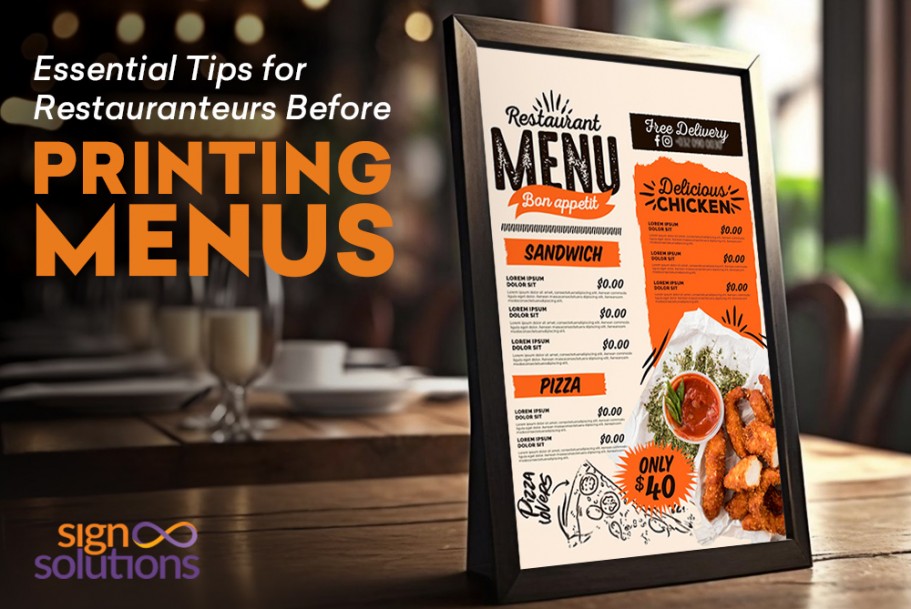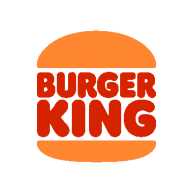Sign Solutions has been our "Go-To" source for all of our Corporate sign, banner and vehicle branding needs for years. Their team is always extremely responsive and their product quality is exceptional for the price. We highly recommend the services of the Sign Solutions!
Essential Tips for Restaurateurs Before Printing Menus
No industry is free from competition, and restaurants are no exception to this fact. But every restaurant has a unique tool that attracts customers and assures them of quality, hygiene, and authentic taste with an ambiance and aroma to spell its food magic.
What we are talking about is the menu. Soon after the customer enters your restaurant and secures his table, the first thing he is greeted with is a well-designed menu. The menu is more than just a list of dishes. On the contrary, Best Menu Cards for your Restaurant is still a powerful marketing tool that builds the foundation of your restaurant and influences its success.
A well-structured restaurant menu with mouth-watering recipes has the power to attract customers and influence their ordering decisions. Your menu also has a secret skill to build your customer's appetite as soon as he starts reading it.
If you own a restaurant and wish to deliver a memorable dining experience to your customers, then this blog is for you. Let's discuss a few essential tips to consider for restauranteurs before printing your menu.
Understanding Your Audience
Creating an eye-catching menu is important for your restaurant. But, identifying your target customers and understanding their tastes, likes, and dislikes will play a major role in designing a menu that very well resonates with them.
To identify your target audience, you must extensively research their demographics, preferences, and dietary restrictions. The values from these parameters will enable you to tailor the menu's content, indicate the right placement of food by their categories, and conclude with an appealing design to meet their expectations.
The knowledge that you will gain from your research will allow you to choose the right dishes, portion sizes, and price points. All these put together will be instrumental in formatting an appealing menu for your ideal customers. Your menu shouldn't be limited to just listing your dishes; instead, it should drive sales by converting occasional customers to returning patrons.
Example 1:
Suppose you own a Quick-Service Restaurant (QSR) in a busy corporate area. Here, your target customers will be young professionals (with busy lifestyles) aged 25 to 35 years serving at various corporate establishments.
In this case, you should include fresh, healthy, tasty, and convenient food options like salads, rolls, wraps, and customizable soup bowls. You may begin by serving healthy breakfasts, go to brunch, and continue with a satiating lunch. You might also walk that extra mile by serving wholesome dinners or easy-to-carry cooked meals that are both hygienic and light on the stomach to allow better digestion at night.
Example 2:
Suppose you operate a Full-Service Restaurant (FSR) or a Casual Dining Restaurant (CDR) near a buzzing shopping mall or a crowded street in the downtown area. Here, your target customers will be families with children, young couples, and even the residents of all nearby buildings.
You would generally witness kids visiting your area with their parents on weekends or public holidays. Begin by offering non-spicy, kid-friendly dishes at your restaurant. Besides your regular menu, make sure to have a dedicated menu for children. Make them feel special by developing a small part of your restaurant as a kid's zone.
Parents love to see their children happy. Happy and satisfied children can bring in more customers. Kids always accompany their parents. Hence, with every kid, you automatically have their parents as your customers. Children have a different palate than their parents. Therefore, create menus that match different taste buds and keep them unique. Instruct your staff to be careful while servicing the orders.
Presentation of food is equally important as their taste. Include fun elements while serving food to children. Present food dishes for adults in the most decent manner. Ensure the right etiquette while serving every table in your restaurant.
As you see, understanding your target customers' needs and preferences will help you create menu versions that are attractive, appealing, and relevant to them.
Emphasize Popular and Profitable Items
Just one search on Google is enough to display a list of restaurants serving delicious cuisines, so why should anyone visit your restaurant? The answer is present in your menu. You should plan smartly and accurately to place your most popular and profitable dishes on your menu. They should be prominently featured on your menu for optimum visibility and to entice your customers.
Just displaying your food items as simple text doesn't make sense. You must use eye-catching designs that include elements like bold fonts for headings and sub-headings, contrasting colors for clear visuals, or even attractive graphics to make your classic dishes stand out.
You can consult experts at a Menu Printing Company in Cayman. They would guide you for sure about placing these dishes at the top of the menu, in the center, or a visually prominent section.
They can also create draft options showing the balance between menu content, outline design, and white spaces to make your menu look fantastic. Your menu shouldn't be overloaded with information. It should rather be created decently to draw customers' attention and increase the chances of them ordering these items.
Craft Clear and Descriptive Item Descriptions
Not everyone is thorough with the terminologies used in a menu. Hence, using descriptive language and enticing descriptions can influence your customers' decisions.
Every restaurant wants its menu to appear appealing. Therefore, displaying the food items with clarity and enticing descriptions can make all the difference.
Visualize your menu card as a beautiful canvas. Don't list your ingredients as a simple text. You can instead use descriptive language to paint a lovely portrait of the dish's flavor, texture, and presentation. Writing "chicken salad" might not create that impact. But describing the same recipe as "Tender grilled chicken on a bed of crisp greens, tossed in a tangy lemon vinaigrette" will make it irresistible for your customers. There isn't a possibility for them to miss out on such a juicy description.
Use explicit language to portray your menu as a collection of mouth-watering delicacies. Allow your customers to imagine the taste virtually, appreciate the aroma, and experience the uniqueness of every dish. This strategy will not only tickle their taste buds but enhance the probability of ordering those dishes again.
If you're searching for the Best Menu Cards for your Restaurant, consider working with Sign Solutions, Cayman. Our expert designers can create visually appealing menus that are creative enough to complement your descriptions and branding.
Design for Readability and Aesthetics
Always remember:
Your Menu Card is your restaurant's “Brand Ambassador.”
Hence, the details it carries must be well-placed, readable, and aesthetically pleasing. Ensure that you create a menu that makes your customer feel special while reading through it.
Visual appeal and ease of reading are closely associated and should be an integral part of a well-designed menu. Wouldn't you love to navigate through a clean, organized menu layout that makes it easier to find your favorite food items? The same holds for your customers. Hence, choose fonts that are easy to read.
Experts at Best Menu Printing Company in Cayman can suggest fonts like Sans-serif, Arial, or Helvetica. It makes no sense to use too decorative or cursive fonts that are difficult to decipher. You might someday have elderly or senior citizens visiting your restaurant. On other days, the welcoming aroma of your delicious food might entice physically challenged customers or those with visual impairments to visit your outlet. How about having a menu that offers them the necessary clarity about the available food items and eases their task of ordering ones that appeal to them?
The standardized solution will be to use an adequately large font size that is easily legible even from a distance. It will especially benefit customers wearing glasses or facing difficulty reading small fonts. Even with having a larger font size, you must be mindful of the overall design. Too large fonts will make your menu look cluttered and congested, and it will eventually lose its charm.
Now that you have used the best fonts, it is time to make them impactful. Use contrasting colors or backgrounds to make the text stand out and highlight important information about the names of dishes, chef’s special delights, or special combo offers.
Your special kids' menu:
Create it in a multi-colored format.
Place a few cartoon characters vividly.
Let your menu engage with children.
Caution: Avoid using too many colors in your regular menu, as it can be overwhelming and make reading difficult. Using a simple color scheme with one or two primary colors will maintain its charm and effectiveness.
White space plays a prominent role in enhancing the overall beauty of your menu. Hence, always make sure that there is adequate white space between printed menu items. Using white space correctly will prevent the page from looking cluttered and increase the pleasure of reading.
Suppose the food items printed on the menu are pearls. In that case, the white space is the ocean that encapsulates the charm, beauty, and visual appeal of your restaurant's menu by delivering a sense of balance and aesthetics. Using white space consistently will generate engagement and endow your menu with magnificent looks.
Integrate Branding Elements
The moment you see the logo, design, and other branding elements on a menu card, you easily recall that restaurant. Every restaurant, small or big, must follow this strategy for the simple reason that your menu card is an extension of your restaurant's brand and a true reflection of how you perceive it.
If your restaurant is unique, and so are your mission, vision, and beliefs, then why should your menu be similar to that of your neighboring restaurant? Hence, experts suggest having a menu layout that reflects your unique identity in every aspect. A straightforward method is to incorporate elements like your logo, signature colors, and typography into your menu, giving it a cohesive look and feel. This look will allow your menu to carry the personality and values of your brand.
A logo is not just a combination of a few design symbols. It is actually the conceptual projection of an idea on which your business is constructed. Your logo is the most recognizable and memorable creation that symbolizes your restaurant. You must ensure that it is displayed prominently on your menu to help customers recognize your brand immediately.
The font you select for your restaurant's name must align with and complement your logo to reflect your restaurant's elegant "Style Statement." Be consistent in using your signature colors throughout the menu's content and design.
Create a visually appealing and cohesive design to uphold your brand. You can consult a Sign Maker in Cayman to help you determine your signature colors based on the essence of your restaurant. These signature colors have a psychological influence on your customers' desires, emotions, and likes while conveying your core values to them.
Maintaining consistency throughout your branding process fosters customer engagement and creates a memorable customer experience. Using the same (specific) colors, fonts, and designs across all your marketing channels will not only strengthen your brand's identity but forge a lasting impression on your customers. This consistency also helps to build trust, loyalty, and brand value that convert casual customers to loyal patrons.
Price Items Strategically
Precisely pricing your menu items is a strategic game, while placing those items in locations that attract customer's attention is a psychological game. You can align with an Experienced Menu Printing Company in Cayman. They can guide you into deploying both these game plans to maximize your restaurant's profitability and credibility.
You must thoughtfully consider the following factors.
- Your target market's budget,
- The perceived value of your dishes,
- Your desired profit margin.
With proper planning, calculated risks, and psychology techniques, you can become a pro at influencing customers' price decisions and entice them into becoming your returning customers.
Currency symbols aren't friends.
Avoid using them on your menu.
Placing currency symbols before your prices can make them (prices) seem less concrete and more abstract, which can reduce perceived costs. Charm pricing is a prevalent and favored concept amongst restauranteurs; consider using it. Setting your item prices at $9.99 instead of $10.00 will make more sense by attracting customers. Charm pricing creates a magical lower-priced impression when your customers read your menu. In the actual sense, the price difference is minimal.
Place high-profit items in your menu's strategic locations.
Locations such as the top of the menu, central section, and visually prominent sections are considered strategic locations. This strategy is capable of drawing customers' attention and increasing the chances of ordering high-profit food items.
These factors have yielded proven results, yet you must carefully consider them in the right context. There are brighter possibilities for optimizing your menu pricing and enhancing your restaurant's profitability.
Proofread for Accuracy
Any text that goes public must always be proofread. Hence, before printing your menu, you must carefully proofread it. Proofreading ensures that your menu is free from all possible spelling, grammar, typos, and pricing errors. You must also make sure that no mistake misses the human eye.
When an erroneous menu reaches your customer, it can have a devastating effect, damaging your restaurant's credibility and eroding its trust. Even the smallest of typos or pricing errors can negatively impact your goodwill, wreak your impression, and discourage customers from visiting you again.
As your menu is an extension of your restaurant's brand, you must take time to review your menu multiple times. You can avail yourself of the services of a professional proofreader and allow him to double-check the menu draft for its accuracy and quality. Proper proofreading creates a picture-perfect menu that demonstrates the precise details and upholds your restaurant's commitment to excellence.
Your customers will be truly delighted to know that you care about the quality of your food and service. They would also appreciate your ideology, which will further help strengthen your brand value, trust, and loyalty.
When proofreading your menu, pay close attention to the following:
Spelling: Check for any misspelled words, especially those that are commonly confused, such as "their," "there," and "they're."
Grammar: Ensure that your sentences are grammatically correct and that there are no punctuation errors.
Pricing: Verify that all prices are accurate and consistent throughout the menu. Double-check for any discrepancies or errors that could lead to confusion or dissatisfaction among customers.
You can either hire a professional proofreader or take the time to proofread the menu yourself. In both these scenarios, you will be able to get rid of costly mistakes and create a positive impression on your customers.
Seek Feedback and Make Revisions
Feedback is a much milder combination of appreciation and criticism. But the biggest benefit of collecting feedback is that it works like a torchbearer for you. This torchbearer shows you the possible avenues needing improvement and those aspects that have achieved success.
In short, it is mandatory to gather feedback from your restaurant staff and also from a group of customers you can count on. The exercise of gathering feedback will provide you with valuable insights. You must use these insights to make your menu more effective, more meaningful, and more memorable.
As a restaurant operator, you have two go-to options for getting your feedback. You may gather your feedback either from your staff or your customers.
Staff Feedback: Your employees are the closest to you, and they understand your business and its ideology very well. Hence, asking them for their genuine opinions, feedback, and reviews on the menu's content, layout, readability, and appeal of the dishes will help you make constructive modifications.
More relevantly, they are familiar with the restaurant's menu on a daily basis. They already have a clear picture of each section, each food category, and their orientation in your menu card. They may not speak out unless asked, but they can provide valuable insights and actionable suggestions depicting the menu's strengths and weaknesses. You can schedule a staff meeting, gather their feedback, and understand their viewpoint about the menu and the food items mentioned therein.
Customer Feedback: Not every customer would be so willing to share his genuine feedback or opinion about your menu card. Some customers might consider this exercise a waste of time and might give your request a cold shoulder.
So then, how would you go about completing this mission?
The best thing you can do is start interacting with a few selected customers coming down to your restaurant. Observe the manner in which they respond or reply to your (general) questions. If you find their responses, body language, and answers reasonable enough, then you can add them to your small group.
Conduct a focus group meeting with that small group of customers. Get their feedback on the menu's design, pricing, and the overall dining experience. To have 360° feedback, you must select customers from a diverse range of demographics, food habits, and preferences. Attempt to gather a variety of perspectives from the small group. Use various channels, such as in-person, over the phone, or online, to conduct the focus group.
Never take feedback or opinions either from your staff or customers at face value. Always ask questions that trigger responses, which can be categorized as constructive feedback. Such feedback helps you identify issues or areas needing improvement. Use their feedback to make necessary improvements to create a menu that is appealing, effective, and error-free.
Let's understand this concept with an example:
Suppose customers complain that the menu is difficult to read (and understand). In that case, your first step must be to understand the customers' pain points and their challenges. Based on their insights, revise the layout, font size, type, and color to improve readability.
You might also face customers who keep complaining about high prices. Make them happy by adjusting the pricing of certain items. Offer them special discounts, or treat them to combo offers. Make them feel privileged. You will soon witness days when they stop complaining and begin relishing your cuisine delights.
Create a menu that fulfills your customers' needs and preferences and helps you achieve success milestones.
Plan for Menu Updates
To keep pace with time, we humans need to upgrade, and so do things associated with us. This stands true for food, clothing, work, habits, and even your restaurant's menu card. Don't let it stale. Regularly updating it gives your customers an opportunity to try new dishes and share their feedback. At the same time, you earn a chance to interact and engage with them.
Keeping your menu fresh and appealing through regular updates must be an essential strategy for your business plan. Every season brings in new vegetables, fruits, and condiments to help you show your unique culinary skills. Complement your skills and attract your customers with distinctive tastes, flavors, and awesome presentations. Check out your customer's feedback. They offer you an opportunity to keep your menu fresh and relevant.
Seasonal Changes: "New season, new arrivals" - A phrase that attracts us all. Consider updating your menu to reflect the seasonal availability of fresh ingredients. Let these fresh ingredients help you create dishes that are both delicious and suitable to your customers' palates. For a simpler understanding, you could offer lighter, fresher dishes during the summers and heartier, greener, warming dishes during the winters.
New Dishes: You might have seen a few customers checking out "What's New" the moment they have your menu in their hands. Surprise them by introducing new dishes periodically, eventually converting them into regular customers. You should schedule regular meetings with your chef and his team to develop original recipes or add popular and trending flavors to your new arrivals category. Please keep an eye on the new dishes. Test and taste them before adding them to your menu. Offer free samples to your genuine customers and request ratings and opinions from them. Be sure to check if they taste delicious while being profitable (and affordable).
Customer Feedback: While creating your menu, position yourself as your customer. Paying attention to customer feedback doesn't mean only reading literally. You should also read between the lines to understand its crux. If customers are requesting specific dishes or expressing dissatisfaction over certain items, make necessary changes to address their needs, followed by testing those dishes after the changes.
By incorporating the above suggestions, you can ensure that your menu remains exciting and appealing while matching your customer's preferences.
Conclusion
By now, you would have had a complete idea of the essential tips that go a long way in making your menu a success. As a restauranteur, you must create menus that are both visually appealing and effective in attracting and retaining customers. Also, consider a menu for children.
Remember: Your menu is your brand ambassador and a powerful marketing tool. Use it to significantly impact your customer's decisions and achieve your restaurant's success.
Identifying your target audience must be your primary purpose while creating your menu. Highlight your best-selling dishes, use descriptive language, and incorporate branding elements. Make necessary changes and upgrade your menu regularly.
Gather your customer's feedback and work on improving your dishes. Give your best shot while creating your menu so that it leaves a lasting impression on your customers and fosters business growth for your restaurant.
Boost Your Appetite with Stunning and Creative Menu Cards from Sign Solutions.
If you own a restaurant and wish to create a menu that truly captivates the customers' attention, then Sign Solutions, Cayman is the best menu printing company to align with. We specialize in designing and printing menu cards that are both visually stunning and informative.
We craft your menu cards with the highest quality materials and print them in vibrant colors, making them the best menu cards for your restaurant. Our experts can customize your menu using your brand name, logo, and signature colors. Through our years of experience, we can personalize your menu with images of mouth-watering dishes directly from your kitchen.
Contact us today to plan your next menu that leaves a lasting impression on your customers and encourages them to return for more.
Recent Blog

Why a Fascia Sign is a Great Choice for Your Store?
Fascia signs can enhance your store’s visibility. Learn how this signage improves storefront marketing & increases customer engagement. Read the blo...
Read More
Role of Large Format Printing in Modern Outdoor Advertising
Discover how large-format printing elevates outdoor advertising with vibrant visuals and impactful designs that capture attention and drive engagement...
Read More
Acrylic vs. Glass Signs: Why Acrylic is the Smarter Choice
Discover why acrylic signs outperform glass. Learn about durability, lightweight, safety, versatility, & cost-effectiveness that drive business decisi...
Read More
Why Business Cards Still Matter in the Digital Age
Discover why business cards still matter in the digital age. Learn how they help build lasting professional connections & leave a lasting impression. ...
Read More
Benefits of Using Window Signs for Retail Stores
Window signs enhance retail store visibility, foot traffic, & reinforce branding. Learn how they contribute to a store's success & increase customer e...
Read More









